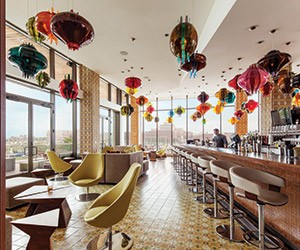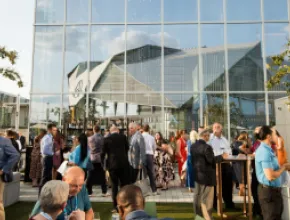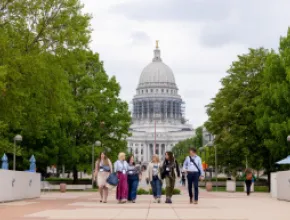Mark 2014 down as the year Indianapolis took the convention crown.
While business has been booming for the Midwestern convention city for years, even during the economic downturn, this year, 10Best (a division of USA Today) made things Facebook official when word spread that Indy was selected as the “Best Convention City” in its readers poll, perhaps giving it the ultimate bragging rights to use in promotional efforts to groups across the nation.
“What’s very cool is that the recognition has helped us get bids from those groups who may have overlooked us in the past,” says Daren Kingi, senior vice president of sales with Visit Indy. “We’re starting to book more national associations and a couple of major corporations because of it.”
From a tourist standpoint, Indianapolis landed the No. 34 spot in The New York Times’ list of “52 Places to Go in 2014,” nestled between Andermatt, Switzerland (No. 33) and the Mekong River in Southeast Asia (No. 35).
In the spirit of celebrating all things Millennial this issue, following is a breakdown of what makes Indianapolis a top choice for today’s meetings and conventions, including the different elements that will appeal to the future generations of meeting planners and event attendees.
1. It’s easy to get around in Indy.
Nothing sours the meeting or convention experience faster than a troublesome incoming flight, and while there’s no guarantee travelers won’t get frustrated along the way, Indianapolis International Airport is a safer bet than most for a positive outcome when flying into a city.
Each year, Airports Council International asks travelers to rank their airport experiences, and the LEED-certified Indianapolis airport has been selected as the “Best Airport in North America” for three years running. The most recent write-up praises the airport’s “soaring architecture with abundant natural light; robust art program; great shopping, dining and entertainment; and free Wi-Fi throughout.”
Once you make it into the city, you have to get around. In many major convention cities, this would involve hailing a cab—or catching a ride from Uber or Lyft—and a hefty price tag, depending on demand. And while these services are all available in Indianapolis, the preferred method of transportation is often on-foot or via the downtown Indiana Pacers Bikeshare program.
“We have all the usual transportation, but the fact is you don’t have to use it as much,” Kingi says. “When I first moved here I lived downtown for 83 days, and with the full sidewalks at night it really is a vibrant city, and that’s what Millennials thrive on.”
And let’s not forget, during the frigid Midwest winters, when hotel rates can be affordable for those willing to brave the cold, the Indiana Convention Center has more properties connected via skywalk than any other in the U.S.—that’s 12 hotels and more than 4,700 of the downtown area’s 7,100 rooms available.
2. The Indiana Convention Center is awesome.
It’s likely most of your attendees will at least be using their mobile device or tablet to access the convention center’s network while on-site. And this isn’t a trend that is going to change as the number of Millennials in attendance at meetings and events continues to rise.
Lucky for planners, the 566,000-square-foot Indiana Convention Center (and adjacent Lucas Oil Stadium, home of the Indianapolis Colts) is one of the most well-equipped in the nation to face the growing bandwidth burden, due to major enhancements made in 2011/2012 in preparation for Super Bowl XLVI.
Major tech upgrades made by Smart City Networks, a telecommunications company, included a bandwidth jump from one 100Mbps and one 45Mbps to three 1Gbps connections, which are sourced from two providers; a Wi-Fi density overhaul from roughly 400 access points to just under 1,100 access points; and the addition of 802.11an support.
Beyond the extensive tech infrastructure, Lucas Oil Stadium opened in 2008, offering an additional 183,000 square feet of exhibit space when football is not in session.
PageBreak
3. Indianapolis is home to hip neighborhoods and nightlife.
Millennial attendees are more likely to want to get out and explore the surrounding neighborhoods, and Indianapolis provides easy access to a bustling arts, culture and entertainment scene.
Downtown Indianapolis is home to six unique cultural districts, including Broad Ripple Village, Fountain Square, Mass Ave, Indiana Avenue, White River State Park and the Wholesale District.
Fletcher Place, which is sometimes included as a part of Fountain Square, is particularly notable for its trendiness, with a growing number of craft breweries and distilleries such as the recently launched Hotel Tango Whiskey, where attendees can network over an artisan cocktail.
“Fountain Square is booming with restaurants and craft breweries, but craft distilleries are really the next wave in the area,” says Lisa Wallace, communications manager with Visit Indy.
Fletcher Place is located near The Alexander, a hip, Millennial-friendly, 157-room hotel that features 16,500 square feet of event space and emphasizes creative meeting setups to motivate groups.
4. Attendees can take a walk (or ride) along the Cultural Trail.
The Indianapolis Cultural Trail was the highlight of our 2013 Indy coverage, and for good reason. The eight-mile-long, $63 million trail connects downtown’s main cultural districts, including those noted for hip nightlife and entertainment options, along with the scenic White River State Park.
White River State Park is touted as “America’s only cultural urban state park” and is home to the Indianapolis Zoo, which can be utilized for private group events if you’re looking to mix things up. Or if your group is keen on outdoor adventures, they can kayak down the Central Canal in warmer months.
Perhaps the greatest benefit of the Indy Cultural Trail is that it encourages visitors to explore all of the Indianapolis area, versus sticking to just one spot, truly getting them in tune with the city.
5. Don’t forget about sustainability.
While the Midwest has shown significant improvement over the years in sustainability efforts, many of its cities still pale in comparison to the West Coast innovators. That’s not necessarily the case in Indy.
“Sustainability is very important to the city,” Kingi says. “You don’t have the congestion that you would have with larger cities. People who live downtown don’t necessarily need cars to get around.”
Beyond walkability, the previously mentioned Indianapolis International Airport was the first LEED-certified airport in the nation and is home to the world’s largest airport-based solar farm.
And with the incoming launch of BlueIndy in 2015, Indianapolis is set to have the largest all-electric car-sharing program in the nation.
Meanwhile, the city’s new $20 million Transit Center is also scheduled to open next year and include the largest fleet of fully electric city buses in the nation, which will utilize solar panels for power.







